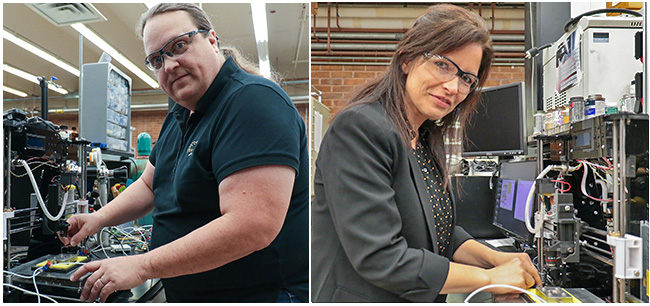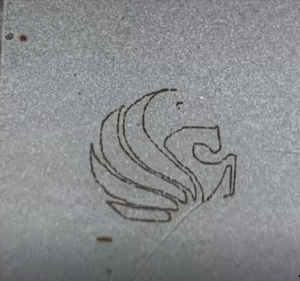Collaborators Develop a Clean Way to Recycle Methane into Green Energy
July 2023
By Kathleen Snoeblen
As research collaborators for the past 10 years, nanotechnologist Laurene Tetard, Ph.D., and catalysis expert Richard Blair, Ph.D., are all too familiar with the old saying, “If at first, you don’t succeed, try, try again.” Tetard says, “It took a while to get some really exciting results. In the beginning, a lot of the characterization that we tried to do was not working the way we wanted. We sat down to discuss puzzling observations so many times.”
Yet, they plowed forward, and their perseverance has paid off. The team has developed three innovations. Two enable green and blue energy production from methane. The third provides a method for producing carbon micro and nanostructures for nanoelectronics, biotechnology, and applications not yet developed.

Figure 1. UCF researchers and long-time collaborators Dr. Richard Blair (left) and Dr. Laurene Tetard (right).
“Richard has a million different ideas on how to fix problems. So eventually, we would find something that works,” Tetard said.
She and Blair joined forces shortly after meeting in 2013 at UCF’s Physics Department. Blair had just discovered catalytic properties in boron nitride that were “unheard of” and wanted to publish the information and do more research. But he needed someone to help characterize the findings. “At the characterization level, that’s not where my strength is,” he said. “I have strengths that complement Laurene’s strengths. It made sense to see if we could do something together and if she could add some insight to what we were seeing.”
So, in collaboration with Dr. Talat Rahman and funding from the National Science Foundation, they hoped to gain a molecular understanding of the catalytic properties in defect-laden hexagonal boron nitride (dh-BN), a metal-free catalyst. The team also thought that the catalysts and methods from their research could lead to greener syntheses and provide a sustainable source of hydrocarbon fuels and feedstocks.
Blair attributes their success to their different specialties. “That’s where you see your good collaborations,” he said. “Where people bring complementary skill sets together to be better, bigger, than each single person.”
Making Green Energy Using Boron Nitride
Sometimes called “white graphite,” boron nitride (a mix of boron and nitrogen) and its slippery properties have had many industrial uses, but not for catalysis. “Until we came along, that kind of boron nitride was considered just inert. Maybe a lubricant, maybe for cosmetics. But it didn’t have any chemical use,” Blair said. However, with defect engineering, the research team found that the compound had great potential for producing carbon and green hydrogen, possibly in large volumes.
A Better, Cleaner Technology for Producing Carbon
The first technology that the team developed is a method for making carbon from dh-BN using visible light. It came unexpectedly. Blair explained that to analyze the catalyst’s surface, they would place it in a small container, pressurize it with a hydrocarbon gas (such as propene), and then expose it to laser light.
“Each time, it did two things that were frustrating,” he said. “The catalyst itself emitted light that obscured any data we needed, and the student kept saying, ‘it’s getting burned’ and I would say that’s impossible. There’s no carbon on the catalyst,” Blair said.
“And there was no oxygen,” added Tetard. They were stumped.
“If we wanted to study that burning spot, it needed to be bigger,” she said. Once they managed to produce a larger sample, they put it under the electron microscope. “We started seeing some lines, but it’s powder, like this loose, messy powder, so it shouldn’t be ordered,” Tetard said. “But when we zoomed in some more, we saw some carbon and lots of it, with the dh-BN powder clinging to the top of it.”

Figure 2. When focused, green laser light induces cracking of hydrocarbons over defect-laden h-BN (dh-BN) powder (left), and solar energy can be harvested for the same chemistry using a concentrating lens (right).
What was seen as a problem was actually serendipitous, Blair said. They discovered a new way to produce carbon and hydrogen through a chemical cracking of hydrocarbons with energy supplied by visible light coupling with a metal-free catalyst (dh-BN). Compared to other methods, it’s also better because it doesn’t require significant energy, time, or special reagents/precursors that leave impurities. All that’s left is carbon and some traces of boron and nitrogen, none of which are toxic to humans or the environment. The technology lends itself to many applications, including sensors or new components for nanoelectronics, energy storage, quantum devices, and green hydrogen production (more about that next). Learn more about UCF’s Photochemical Transformation technology.
A Better, Cleaner Technology for Producing Hydrogen
That first finding led directly to the second technology: using visible, low-temperature light (such as a laser, lamp, or solar source) and dh-BN photocatalysts to produce hydrogen from hydrocarbons.
According to Blair, the “burning” they saw was a way of ripping the hydrogen off the hydrocarbon and making carbon. “It’s called dehydrogenation, a really important process, and we need to look at it,” he told the team. While studying the effects, they wondered whether the catalyst would work with lower-value hydrocarbons, like methane (CH4), a waste and greenhouse gas. Tetard and Blair used propene in the first study. However, they could only get the dark spot to grow with methane after trying different lasers and using more energy. Blair and his students engineered a material structurally similar to boron nitride but with better activity for methane dehydrogenation.
“That invention is actually a twofer,” said Blair. “You get green hydrogen, and you remove—not really sequester—methane. You’re processing methane into just hydrogen and pure carbon that can be used for things like batteries.” He said that traditional hydrogen production uses high temperatures with methane and water, but in addition to hydrogen, that process also generates carbon dioxide (CO2), another greenhouse gas. According to the US Environmental Protection Agency, methane’s (CH4) lifetime in the atmosphere is much shorter than CO2, but CH4 is more efficient at trapping radiation than CO2. “Pound for pound, the comparative impact of CH4 is 28 times greater than CO2 over a 100-year period,” notes the EPA.
“Our process takes a greenhouse gas [methane] and converts it into something that’s not a greenhouse gas and two things that are valuable products [hydrogen and carbon],” Blair said. “And we’ve removed methane from the cycle.” He noted that at the Exolith Lab of the Florida Space Institute, they were able to generate hydrogen from methane gas using sunlight by putting the system on a large solar concentrator. Knowing this, he said countries that don’t have abundant sources of power could use the invention since all they would need is methane and sunlight. Besides oil and natural gas systems, methane exists in landfills, industrial and agricultural areas, and wastewater treatment sites. Learn more about UCF’s Hydrogen Production technology.
Growing Contaminant-Free Carbon Nano/Microstructures
The third technology developed by Tetard and Blair is a method for producing carbon nanostructures with controlled dimensions. It uses light and a defect-engineered photocatalyst to make patterned, well-defined nanoscale and microscale structures from numerous carbon sources. Examples include methane, ethane, propane, propene, and carbon monoxide.
“So, the dream is to make high-performance carbon materials from methane, and it’s not done very well right now,” said Blair. “So, this [invention] would be a way to make such materials from methane in a sustainable manner on a large industrial scale.”
Tetard noted an example in which Blair printed carbon with precise dimensions, as shown in Figure 3.
“It’s like having a carbon 3D printer instead of a polymer 3D printer,” Tetard said. “If we have a tool like this, then maybe there are even some carbon scaffolding designs we can come up with that are impossible today.”
Measuring a half-inch by a half-inch, the image is “just carbon we deposited quickly,” said Blair. “You can hold it in your hand. But let’s say you want to go down to a smaller scale. The carbon structures produced are very tiny, and you can arrange them precisely, and give them precise sizes and patterns. Now you’re talking high-dollar applications, perhaps for medical devices or new chemical sensors. This becomes a platform for developing all sorts of products. The application is only limited by the imagination.” Since the growth process is tunable at different wavelengths, design methods could incorporate various lasers or solar illumination.
Tetard added that her lab, which works at the nanoscale, is now trying to reduce the size. “We’re trying to think of a way to learn from that recipe or that process and see how we could make it work at even the smaller scales—control the light in a tiny volume. Right now, the size of the structures is microscale because the light focal volume we create is microsize. So, if we can control the light in the tiny volume, maybe we can grow nano-sized objects for patterned nanostructures a thousand times smaller. That’s something we’re thinking of implementing in the future. And then, if that becomes possible, there are many things we can do with that,” she said. Learn more about UCF’s Contaminant-Free Carbon Nano/Microstructure technology.
About the Researchers
Blair holds a doctorate in materials chemistry from the University of California at Los Angeles. He joined UCF in 2007 and is an expert in catalysis for applications, including the catalytic processing of bio-derived compounds for fuels and chemical feedstock. He is now a research professor at the Florida Space Institute and a Fellow of the National Academy of Inventors. See the Blair Research Group site for more information.
Tetard received her doctorate in physics from the University of Tennessee, Knoxville, and joined UCF’s NanoScience Technology Center and Physics Department in 2013. She is an associate professor and also the associate chair of the department. Tetard specializes in developing high-resolution microscopy and spectroscopy tools to advance the level of understanding of the behavior of materials and complex systems. See the Tetard Research Group site for more information.
Technology Available for License
To learn more about the research team’s work and additional potential licensing or sponsored research opportunities, contact Andrea Adkins (andrea.adkins@ucf.edu) at (407) 823.0138.
